Bulletin – September 2010 A Guide to the Card Payments System Reforms
- Download the article 275KB
Abstract
Studies by the Reserve Bank undertaken from 2000 to 2002 concluded that the structure of pricing in the Australian card payments system was encouraging inefficient use of credit cards relative to EFTPOS. From 2003, therefore, the Bank progressively introduced reforms to address this issue: ‘interchange fees’ were reduced; merchants were permitted to reflect the cost of different payment instruments in their prices to consumers; and merchants were provided with more freedom to choose the payment instruments they accept. The effect of these changes was to increase the price to cardholders of using a credit card relative to EFTPOS, thereby reducing the incentive to use the more costly payment instrument (credit card) over the less costly one (EFTPOS) and reducing the overall cost of the payments system. The reforms also strengthened the ability of merchants to put downward pressure on the fees they pay when they accept cards.
Introduction
When most cardholders swipe a card at a retailer to purchase goods and services, they are probably unaware of what happens behind the scenes between the time the card is swiped and when the merchant is finally paid. There is, however, a detailed set of arrangements between financial institutions that ensure that the merchant is paid and the cardholder's account debited. Historically, these arrangements have been very opaque. But since 2000, the Bank has undertaken a detailed analysis of these arrangements and their implications for the efficiency of the Australian payments system. As a result of this work, the Bank has progressively introduced a number of reforms to card payment systems which have had an impact on both cardholders and merchants accepting payment cards. Among other things, these reforms have altered the prices that cardholders face when using debit and credit cards, reducing the incentive to use a higher-cost payment method (credit cards) instead of a lower-cost payment method (EFTPOS). This article provides a non-technical summary of the reasons for the reforms, the reform process and their impact.
Essential Concepts
There are a number of essential concepts that underpin any explanation of the card payments system reforms. These are payment systems, interchange fees, and no-surcharge and honour-all-cards rules.
Payment systems
Payment systems are arrangements between financial institutions that allow their customers to make payments to, and receive payments from, other people without using cash. The person making the payment has his/her account at a financial institution debited and the person receiving the payment has his/her account at a financial institution credited. In order to achieve this, financial institutions must be able to communicate with, and make payments to, one another on behalf of their customers. Typically, therefore, payment systems involve four different parties:
- the person making the payment (payer);
- the person receiving the payment (recipient);
- the payer's financial institution; and
- the recipient's financial institution.
Examples of payment systems in Australia include cheques, debit and credit cards, BPAY and direct credits and debits. These systems are used to make non-cash payments between individuals, from individuals to businesses and government, between businesses, and from businesses and government to individuals.
Interchange fees
Financial institutions typically charge fees to their customers for payment services. Customers making payments (such as cardholders) are charged by their financial institution in a variety of ways. In the case of payments from a deposit account (such as cheques, debit cards and BPAY), financial institutions typically charge a monthly account-keeping fee and, sometimes, a fee per transaction (or for transactions above a certain number). In the case of payments using a credit card, financial institutions usually charge an annual fee rather than a per transaction fee, and interest is charged on borrowings that are not repaid by a specified due date.
Customers receiving payments (such as merchants providing goods and services) are also typically charged by their financial institutions. The fees paid by merchants usually depend on the payment method. But for credit and debit cards (the focus of the Bank's reforms) merchants are usually charged a ‘merchant service fee’ for every card payment they accept. Some merchants are also charged a fee by their financial institution to rent a terminal to accept the cards.
There is, however, an important feature of the way credit and debit card payments are priced. In addition to customers paying fees to financial institutions, financial institutions also pay fees to one another. These fees are known as ‘interchange fees’. Interchange fees are often not obvious – cardholders and merchants do not typically see them. But they have an impact on the fees that cardholders and merchants pay.
Furthermore, in Australia, interchange fees work differently in the international (MasterCard and Visa) card schemes and the local debit card system (EFTPOS). In the MasterCard and Visa card schemes, interchange fees are paid by the merchant's financial institution to the cardholder's financial institution every time a payment is made using a MasterCard or Visa card (Figure 1). This has two effects. First, the merchant's financial institution will charge the merchant for the cost of providing it with the acceptance service plus the fee that it must pay to the card issuer (the interchange fee). The higher the interchange fee, the more the merchant pays to accept a card payment. Second, since the card issuer is receiving a fee from the merchant's financial institution every time its card is used, it does not need to charge its customer – the cardholder – as much. The higher the interchange fee, therefore, the less the cardholder has to pay. In effect, the merchant is meeting some of the card issuer's costs which can then be used to subsidise the cardholder.
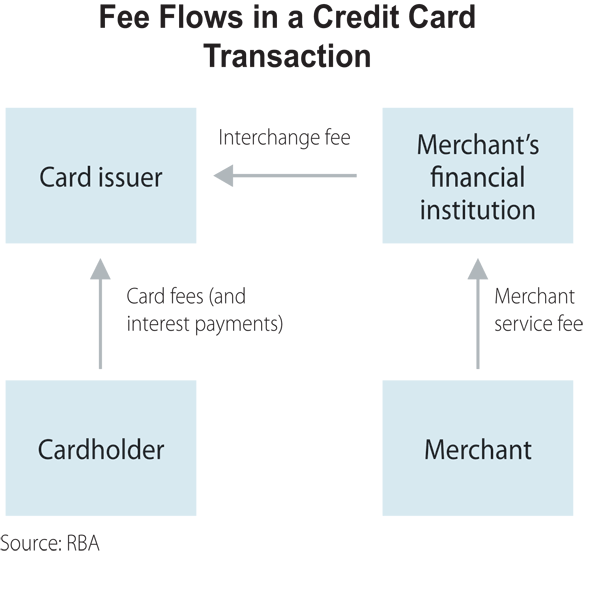
In contrast to the fees charged in the international card schemes, in the Australian EFTPOS system, the cardholder's financial institution pays the merchant's financial institution every time there is an EFTPOS transaction (Figure 2). This also has two effects. First, it increases the cost to the cardholder's financial institution and, potentially, the fee paid by the cardholder to use EFTPOS. The higher the interchange fee, the more the customer is likely to be charged to use EFTPOS. Second, since the merchant's financial institution is receiving a fee from the card issuer, it does not need to charge the merchant as much. The higher the interchange fee, the less the financial institution has to recover from its merchant customer and, if the fee is high enough, the merchant could even receive a fee from its financial institution. In effect, in this case, the cardholder is meeting some of the costs of the merchant's financial institution.
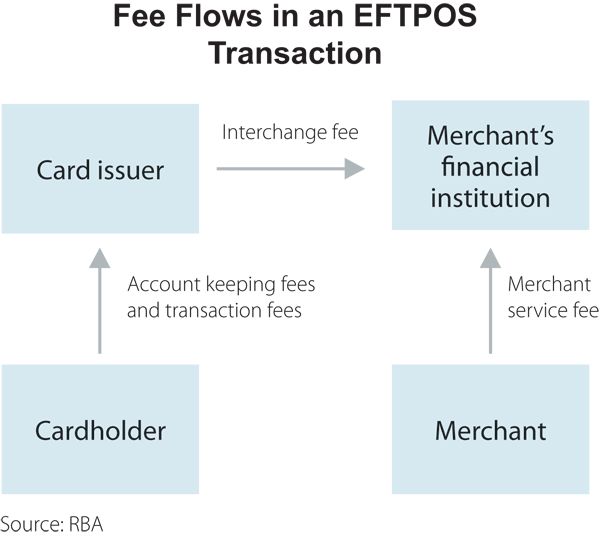
No-surcharge rule
The international card schemes, including MasterCard and Visa but also others such as American Express and Diners Club, have historically imposed rules on merchants that accept their cards. One of these is often known as a no-surcharge rule. This rule prohibited merchants from charging more for accepting the card of a particular scheme than for other payment instruments. While in Australia this rule did not prohibit merchants from providing a discount to customers who paid with cash, it prohibited them from charging more for cards that were more costly to accept. This meant that when using a card, customers did not know that some payment methods were more expensive for merchants to accept than others because customers using more expensive payment methods were paying the same price as customers using less expensive payment methods.
Honour-all-cards rule
A second rule imposed by card schemes on merchants was a requirement that if a merchant takes one type of card issued with a particular scheme's brand, it must take all cards associated with that brand. For example, if a merchant accepted MasterCard credit cards, it was also required to accept MasterCard debit cards, MasterCard pre-paid cards, and any other type of card with a MasterCard brand. This is known as the honour-all-cards rule. Since the schemes already had a large number of merchants accepting their credit cards, this rule ensured that any new products would automatically have a large acceptance base. This provided the schemes with an advantage over other schemes that might have to build up the number of merchants accepting their cards from scratch. And since acceptance was mandatory, it also meant that the schemes could charge a relatively high price to merchants accepting the new product.
The Policy Issues
When the Reserve Bank started to focus on practices in card payment systems in 2000, two main issues arose: prices of using the different types of cards did not appear to reflect their costs; and restrictions on merchants appeared to be inhibiting merchants' bargaining power over the fees they paid.
Prices and costs
In 2000, cardholders were typically paying transaction fees to use EFTPOS but there were no transaction fees for credit cards. That is, it often cost cardholders more to use their EFTPOS card than it did to use their credit card. Most financial institutions charged cardholders for EFTPOS transactions above a certain number a month. A fairly typical account offered 8 fee-free transactions a month and then every EFTPOS transaction above that number cost the cardholder 50 cents. On the other hand, for cardholders who paid off their credit card balance by the due date, there were no fees on transactions. Furthermore, if they received an interest-free period and loyalty points, cardholders were receiving benefits from undertaking credit card transactions. In these circumstances, cardholders were effectively being paid to use a credit card.
This difference in effective prices was not necessarily a concern if it was more costly to financial institutions to provide EFTPOS transactions than credit card transactions. Normally, goods or services that cost more to produce have higher prices and consumers then need to decide whether they receive enough benefit from the higher cost product to justify paying the higher price. But data collected by the Bank suggested that the cost to financial institutions of an EFTPOS transaction was less than the cost of a credit card transaction. This meant that cardholders were paying more to use the lower cost payment method – EFTPOS – than to use the higher cost payment method – credit cards. It was therefore possible that consumers were using credit cards more frequently, and EFTPOS less frequently, than they would if prices more closely reflected costs. Consequently, the cost of making payments was higher than it might otherwise be.
The main reason for this apparent inconsistency was interchange fees. As noted above, in credit card systems, the merchant's bank pays the cardholder's bank a fee every time a credit card is used. In 2000, this fee was around 1 per cent of the value of the transaction. So for a $100 transaction, a card issuer would receive a payment of $1 from the merchant's bank. This was $1 of revenue that the card issuer could use to offset costs and it could therefore lower the price it charged to cardholders or offer such benefits as loyalty points. In the EFTPOS system, on the other hand, the cardholder's bank paid the merchant's bank around 20 cents every time a cardholder made an EFTPOS transaction. Card issuers therefore typically sought to charge cardholders when they used EFTPOS.
So why were interchange fees set in such a way that they generated these outcomes? In the case of EFTPOS interchange fees, the explanation was relatively simple. The fees had been set by negotiation when the system was established in the 1980s to provide an incentive to merchants to install EFTPOS terminals. To change the arrangements required around 8 financial institutions and merchants to renegotiate their bilateral agreements with one another, a task that had proved impossible.
In the case of credit card interchange fees, the explanation was more complicated. In these systems, interchange fees are typically set to encourage financial institutions to issue cards. The higher the fee, the more attractive it is to issue cards and the more benefits the card issuer can offer cardholders to use the cards. At the same time, merchants typically find it difficult to decline acceptance of cards, even if fees are rising. The reason a merchant accepts cards is to sell goods and services so it usually seeks to provide customers with as many payment methods as possible. There has therefore been a tendency for interchange fees to be set at relatively high levels, adding to merchants' costs while providing benefits to card issuers and cardholders.
Merchant restrictions
The restrictions imposed on merchants by the card schemes had three effects. First, since merchants were not permitted to charge customers extra if they used more costly cards, the pricing inconsistency noted earlier was entrenched and cardholders were making payment choices that did not reflect costs. While discounts for cash were possible (and some merchants took advantage of this), this only allowed merchants to have two prices – a cash price and a card price. It did not allow merchants to distinguish between different types of payment cards on the basis of their cost of acceptance. Cardholders were therefore charged the same by the merchant regardless of which type of card they used so they tended to use the card that cost them the least – usually the credit card. They did not need to take into account the fact that credit cards typically cost merchants more to accept than debit cards.
Second, the restrictions limited the ability of merchants to compete down the fees they were charged for accepting cards. There were two ways in which this occurred.
- The no-surcharge rule meant that merchants could not use the threat of surcharging to negotiate lower fees. If a scheme raised its fees, a merchant had only two choices. It could either refuse to accept the card at the new (higher) price or it could pay the new price and build the higher cost of acceptance into the prices of its goods and services. As noted earlier, it often is difficult for merchants to stop taking cards if fees rise. The schemes could therefore increase fees knowing that acceptance of their cards would probably not be affected.
- The honour-all-cards rule meant that merchants were unable to decline acceptance of a new type of card product even if they thought the cost of acceptance was too high. For example, prior to the Bank's reforms, it cost merchants the same to accept MasterCard or Visa debit cards as it did to accept credit cards with the same brand. It was much cheaper, however, for a merchant to accept an EFTPOS card than a MasterCard/Visa debit card even though the payment was made from the same account. But a merchant could not decline to take MasterCard/Visa debit cards unless it was prepared to decline acceptance of credit cards – an unlikely decision as discussed above. MasterCard and Visa could therefore charge merchants a higher price for their debit cards without being concerned that merchants might stop taking these cards.
Third, the restrictions ensured that the high costs of accepting particular instruments were passed on to all consumers, including those that used low-cost payment methods. The no-surcharge rule ensured that those using high-cost cards were not charged an additional fee so the extra cost of accepting these cards was passed by merchants into the prices of goods and services to all customers. And since the honour-all-cards rule allowed the schemes to charge merchants more to accept a new product than they might otherwise pay, it too resulted in higher costs for merchants which were in turn passed on to all customers in the form of higher prices for goods and services.
The Reserve Bank's Reforms
The Bank assessed card payments system issues a number of times between 2000 and 2006. As a result of these assessments, from 2003 the Bank progressively introduced a number of reforms to the debit and credit card systems in Australia. The two main sets of reforms were to reduce interchange fees in both credit and debit card systems to move them closer together and to remove restrictions on merchants. The Bank also increased transparency in card payment systems and allowed new firms into the card systems, increasing competition with the established banks.
Interchange fees
The interchange fees existing in the debit and credit card systems in Australia were affecting the prices paid by cardholders and merchants so that cardholders were being encouraged to use a higher-cost payment method (credit cards) instead of a lower cost method (EFTPOS). But while the Bank brought these issues to the attention of the industry, little was done to address them. From 2003, therefore, the Bank progressively imposed standards on MasterCard, Visa and Australian financial institutions. The effect of the standards was to reduce the size of interchange fees being paid to card issuing banks in the MasterCard and Visa systems and of EFTPOS interchange fees being paid by card issuers to the merchant's financial institution (Graph 1).
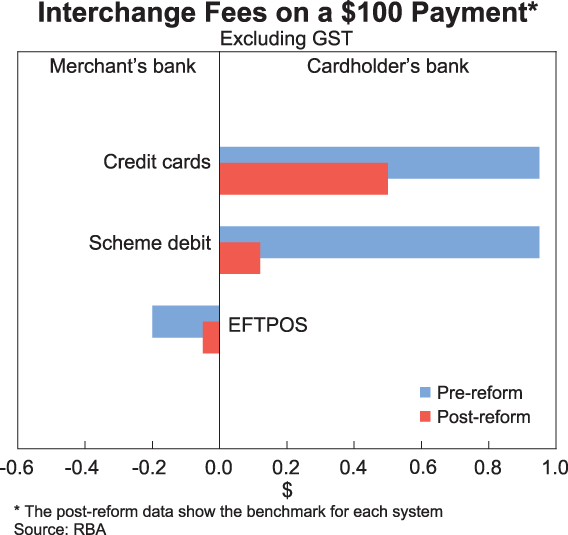
The standard for credit card interchange fees, introduced in 2003, sets a cap on the average interchange fee in the MasterCard and Visa credit card systems. MasterCard and Visa can set a number of different interchange fees for different types of transactions but the average can be no more than a cap based on a number of costs that card issuers incur. Initially, MasterCard and Visa had slightly different caps since they had slightly different costs, but in 2005 the Bank set a common cap for both schemes of 0.5 per cent. This means that, on average, credit card interchange fees paid to card issuers are around 0.5 per cent of the value of the transaction, around half the fee prior to the reforms.
The standards for EFTPOS and Visa debit interchange fees were introduced in 2006. The two debit card systems had very different interchange fees, despite the fact that they were both undertaking an equivalent transaction – transferring money from a deposit account to a merchant. The standards therefore reduced fees in both systems. Interchange fees for MasterCard/Visa debit can average no more than 12 cents per transaction (paid to the card issuer) and EFTPOS interchange fees are to be between 4 and 5 cents (paid to the merchant's financial institution).[1] Given how far apart the fees were to begin with, the Bank decided that it was likely to be very disruptive to make the fees in the two systems the same. The standards did ensure, however, that they were much closer together than they had been.
Removal of merchant restrictions
Since restrictions imposed by the card schemes limited competition in the payments system, the Bank set standards requiring the removal of no-surcharge rules and honour-all-cards rules in Australia. In 2003, MasterCard and Visa were required to remove their no-surcharge rules. In addition, American Express and Diners Club voluntarily removed equivalent rules in their systems; there was no such rule in the EFTPOS system. Removal of the no-surcharge rule provides merchants with another option if schemes choose to increase fees – they can surcharge. A merchant can, for example, indicate to a scheme that if fees are increased (or not lowered), customers using those cards will be charged extra. Indeed, the threat of surcharges might be enough to ensure that schemes do not increase their fees too much. In this way, there might be some competitive pressure on the fees charged to merchants.
There are no restrictions on the size of surcharges, so merchants are free to choose whether to surcharge or not, and the level of any surcharge. But if a merchant chooses to surcharge, it cannot mislead or deceive customers or make misleading statements. For example, merchants are required to inform the customer of any surcharge before the customer enters into the transaction. Furthermore, customers should not be led to believe that the business is required to impose a surcharge, or that it is only recovering acceptance costs if the surcharge is in fact higher than acceptance costs.[2]
In 2006, MasterCard and Visa were required to remove their honour-all-cards rules as they applied to credit and debit cards. This means that merchants can choose to accept, say, a Visa credit card but not a Visa debit card and vice versa. Furthermore, MasterCard and Visa are required to make the cards visually different so that merchants can look at a card and determine whether it is a credit or debit card. Removal of this rule gives merchants another tool to negotiate down the price of acceptance. A merchant can, for example, indicate to MasterCard and Visa that it will not accept their debit cards unless the price of acceptance is reduced. And it can do this while continuing to accept MasterCard/Visa credit cards.
Other reforms
In addition to directly addressing interchange fees and merchant restrictions, the Bank also introduced a number of other reforms to further increase competition. First, it required MasterCard and Visa to publish their interchange fees on their websites, or otherwise make them generally available to the public. Until 2003, these fees had been hidden. While merchants paid interchange fees as part of their merchant service fee, they had no knowledge of the size of these fees. Publication of interchange fees provides merchants with more information to assist in negotiation and increase competitive pressure on these fees.
Second, the Bank required MasterCard and Visa to widen the types of firms that can join their systems. Prior to the reforms, only authorised deposit-taking institutions (ADIs) were permitted to apply to join MasterCard and Visa. In order to increase competition in the credit card market, particularly in providing card services to merchants, the Bank introduced regulations to allow institutions other than ADIs to become members of MasterCard and Visa, and potentially issue credit cards to cardholders or provide card acceptance services to merchants. These institutions are now supervised by the Australian Prudential Regulation Authority (APRA) but need not be deposit-taking institutions.
Effect of the Reforms
The main effect of the reforms has been to change the prices facing users of credit and debit cards. The combination of decreases in interchange fees and surcharging on credit card transactions has resulted in most cardholders paying more to use credit cards and less to use EFTPOS. Furthermore, cardholders are likely to have found that the benefits of using credit cards (in the form of loyalty points earned) have declined. At the same time, merchants have seen the cost of accepting credit cards decline and the cost of accepting EFTPOS cards increase somewhat.
The change in prices to cardholders has been the result of two effects. First, the reduction in interchange fees has resulted in financial institutions changing the prices they charge to their cardholders. With a reduction in the fees received from the merchant's bank, credit card issuers have responded to the loss of revenue by increasing fees and reducing benefits. Annual fees have risen and the benefits from loyalty schemes have been either reduced or capped, sometimes both. This has increased the effective price of using credit cards.
The price to cardholders of using EFTPOS, on the other hand, has declined. Many card issuers have introduced transaction accounts that offer cardholders unlimited electronic transactions (including EFTPOS) for a fixed monthly fee. This change reflects a number of factors, but the reduction in EFTPOS interchange fees as a result of the reforms has made it more viable for institutions to offer accounts that do not have EFTPOS transaction fees.
While the reduction in interchange fees has resulted in some increase in the price of using credit cards, the ongoing presence of loyalty schemes and interest-free periods means that many cardholders are still being encouraged by issuers to use credit cards. This is where the second effect comes into play – surcharging. Since the beginning of 2003, when the no-surcharge rule was removed, the number of merchants surcharging has risen substantially (Graph 2). Survey data indicate that in June 2010, around 40 per cent of very large merchants imposed a surcharge; for small or very small merchants, the percentage was closer to 20 per cent. Although the size of the surcharge varies across merchants, the survey data suggest that the average surcharge imposed is currently around 1.7 per cent for MasterCard and Visa transactions, and around 2.7 per cent for American Express and Diners Club transactions.
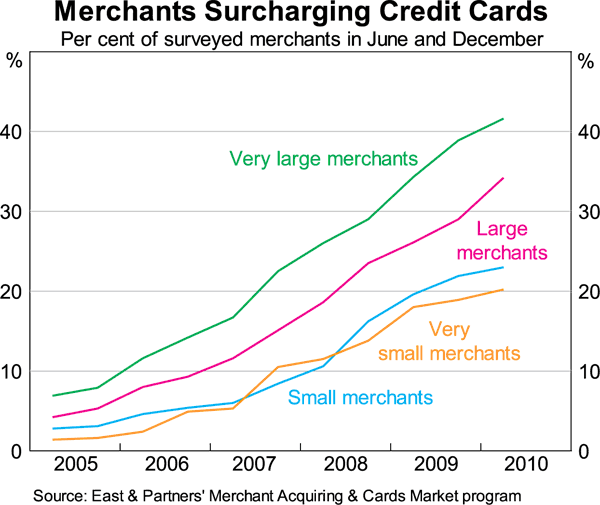
Of all the reforms, the disallowance of no-surcharge rules has probably been the most visible to consumers and therefore has drawn the most reaction. Cardholders had been accustomed to paying the same price for goods and services when using their credit card, while at the same time receiving substantial benefits from loyalty points and interest-free periods. This was an important reason why so many cardholders were choosing to use credit card rather than debit card services that would have been less costly to provide. With surcharging, the prices paid by cardholders to use a credit card are higher. For transactions that are surcharged, the benefits from loyalty points and interest-free credit are likely to be offset, at least to some extent, making the effective net price of using a credit card closer to that for using a debit card. And for consumers who do not pay the balance by the due date, and therefore pay interest, the price of a credit card transaction where a surcharge applies will be even higher. These changes to pricing were not unexpected. Indeed, an explicit aim of the reforms was to alter the incentives to use credit cards as opposed to debit cards.
The effect on merchants has mirrored the effect on cardholders. Financial institutions servicing merchants are now paying lower fees to card issuers for credit card transactions, and this has been passed on to merchants as lower fees for credit card transactions (Graph 3). On the other hand, financial institutions are now receiving a lower fee from card issuers when an EFTPOS transaction is made, so they have responded to this loss of revenue by charging merchants more for EFTPOS transactions (Graph 4). While these effects have been partly offsetting on merchant costs, the net effect of the reforms was a reduction in merchant costs of around $1 billon in 2009/10 relative to what merchants would have paid in the absence of the reforms.
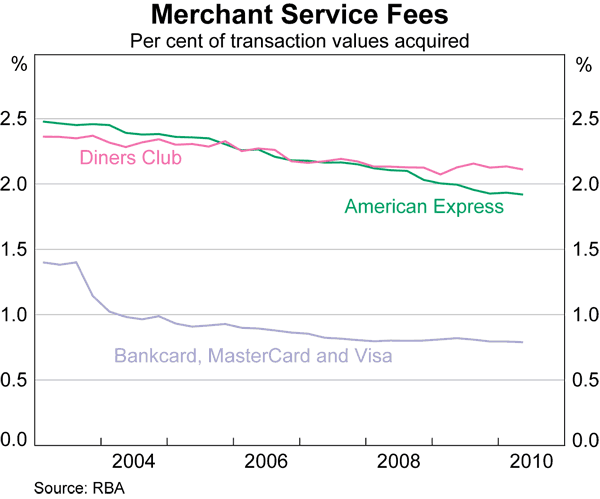
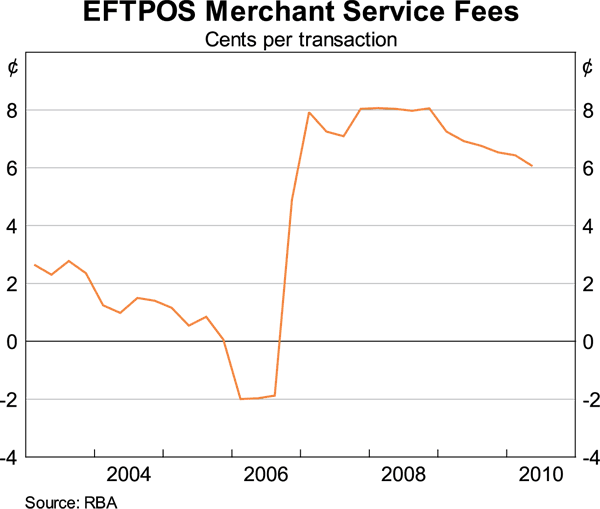
There is evidence that cardholders do react to prices when choosing which payment instrument to use. Surveys indicate that credit card users who pay off the balance by the due date and receive the benefits of loyalty points and an interest-free period undertake more transactions using a credit card than cardholders that pay interest on their credit card; the latter group tends to use debit cards more frequently. Indeed, many credit cardholders who do not pay interest do not use a debit card for any payments. In other words, the pattern of credit and debit card use appears to be influenced by the relative prices faced by different types of cardholder. While it is difficult to measure the precise impact, the number of debit card transactions has in fact been growing more quickly than credit card transactions over the past few years, consistent with the shift in relative prices resulting from the reforms (Graph 5).
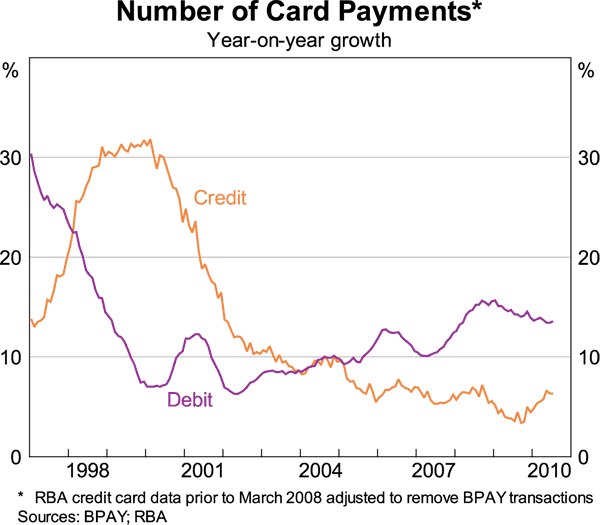
There is some evidence too that the removal of restrictions on merchants has resulted in more competitive pressure on interchange fees and merchant service fees, although this mostly seems to have been confined to larger merchants. Interchange fees paid by larger merchants have been lowered substantially in recent years and merchant service fees charged by American Express and Diners Club have declined, partially reflecting an attempt by these schemes to limit surcharging of their cards.
While the ability to surcharge has been utilised by an increasing number of merchants, only one large merchant has so far utilised the ability to decline acceptance of MasterCard and Visa debit cards. Nevertheless, the removal of the honour-all-cards rule provides choice to merchants and hence provides a source of competitive pressure on the fees charged for debit card products.
Conclusion
The primary objective of the Bank's reforms to the card payments system was to change the relative prices of credit cards and debit cards to cardholders so as to more closely reflect the cost of these payment instruments. Prior to the reforms, cardholders were encouraged to use credit cards by loyalty points, interest-free periods and the absence of fees on transactions, while cardholders were discouraged from using debit cards because they paid transaction fees. The regulated reduction in interchange fees and the removal of restrictions on merchants has altered these relative prices, thereby reducing the substantial incentive to use credit cards over debit cards. In addition, the reforms have strengthened the capacity of merchants to put downward pressure on the fees they are charged for card payment services.
Footnotes
The author completed this work in Payments Policy Department. [*]
MasterCard undertook to voluntarily meet the same cap as specified in the Visa Debit interchange standard. [1]
See <http://www.fido.gov.au/asic/pdflib.nsf/LookupByFileName/news_for_business.pdf/$file/news_for_business.pdf>. [2]